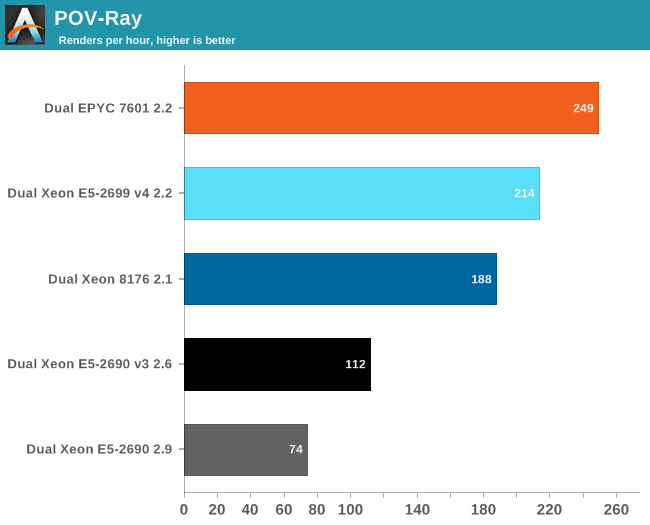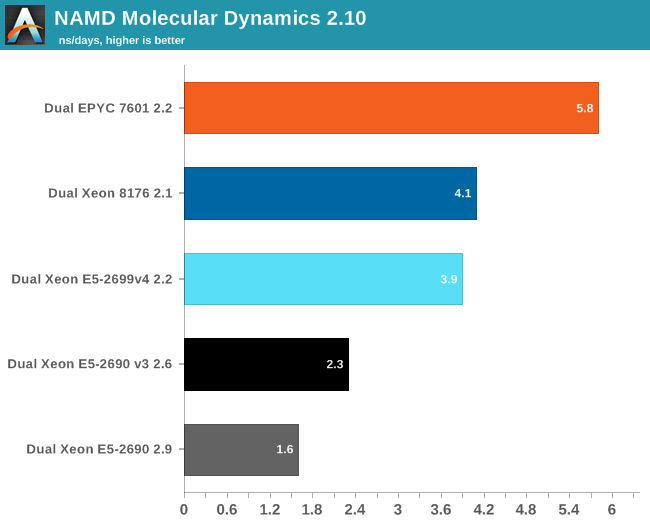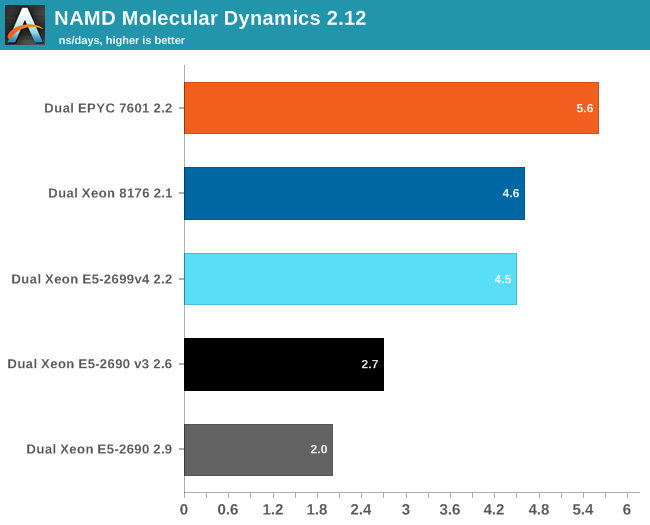Sizing Up Servers: Intel's Skylake-SP Xeon versus AMD's EPYC 7000 - The Server CPU Battle of the Decade?
by Johan De Gelas & Ian Cutress on July 11, 2017 12:15 PM EST- Posted in
- CPUs
- AMD
- Intel
- Xeon
- Enterprise
- Skylake
- Zen
- Naples
- Skylake-SP
- EPYC
Floating Point
Normally our HPC benchmarking is centered around OpenFoam, a CFD software we have used for a number of articles over the years. However, since we moved to Ubuntu 16.04, we could not get it to work anymore. So we decided to change our floating point intensive benchmark for now. For our latest article, we're testing with C-ray, POV-Ray, and NAMD.
The idea is to measure:
- A FP benchmark that is running out of the L1 (C-ray)
- A FP benchmark that is running out of the L2 (POV-Ray)
- And one that is using the memory subsytem quite often (NAMD)
Floating Point: C-ray
C-ray is an extremely simple ray-tracer which is not representative of any real world raytracing application. In fact, it is essentially a floating point benchmark that runs out of the L1-cache. Luckily it is not as synthetic and meaningless as Whetstone, as you can actually use the software to do simple raytracing.
We use the standard benchmarking resolution (3840x2160) and the "sphfract" file to measure performance. The binary was precompiled.

Wow. What just happened? It looks like a landslide victory for the raw power of the four FP pipes of Zen: the EPYC chip is no less than 50% faster than the competition. Of course, it is easy to feed FP units if everything resides in the L1. Next stop, POV-Ray.
Floating Point: POV-Ray 3.7

POV-Ray is known to run mostly out of the L2-cache, so the massive DRAM bandwidth of the EPYC CPU does not play a role here. Nevertheless, the EPYC CPU performance is pretty stunning: about 16% faster than Intel's Xeon 8176. But what if AVX and DRAM access come in to play? Let us check out NAMD.
Floating Point: NAMD
Developed by the Theoretical and Computational Biophysics Group at the University of Illinois Urbana-Champaign, NAMD is a set of parallel molecular dynamics codes for extreme parallelization on thousands of cores. NAMD is also part of SPEC CPU2006 FP. In contrast with previous FP benchmarks, the NAMD binary is compiled with Intel ICC and optimized for AVX.
First, we used the "NAMD_2.10_Linux-x86_64-multicore" binary. We used the most popular benchmark load, apoa1 (Apolipoprotein A1). The results are expressed in simulated nanoseconds per wall-clock day. We measure at 500 steps.

Again, the EPYC 7601 simply crushes the competition with 41% better performance than Intel's 28-core. Heavily vectorized code (like Linpack) might run much faster on Intel, but other FP code seems to run faster on AMD's newest FPU.
For our first shot with this benchmark, we used version 2.10 to be able to compare to our older data set. Version 2.12 seems to make better use of "Intel's compiler vectorization and auto-dispatch has improved performance for Intel processors supporting AVX instructions". So let's try again:

The older Xeons see a perforance boost of about 25%. The improvement on the new Xeons is a lot lower: about 13-15%. Remarkable is that the new binary is slower on the EPYC 7601: about 4%. That simply begs for more investigation: but the deadline was too close. Nevertheless, three different FP tests all point in the same direction: the Zen FP unit might not have the highest "peak FLOPs" in theory, there is lots of FP code out there that runs best on EPYC.










219 Comments
View All Comments
twtech - Thursday, July 20, 2017 - link
I'd really like to see some compile-time benchmarks for these CPUs.For my own particular interests, time taken to do a full recompile of the Unreal 4 engine from source would be very useful. But even something more generic like the Linux kernel compiles per hour benchmark could serve as a useful point of reference.
szupek - Friday, July 21, 2017 - link
Meanwhile, the entire world still runs on IBM's DB2 for Datbases and IBM's Z/AS400 Mainframes. The fastest database in the world, by far...oh and the most secure (it's only hackable by standing in front of the console, seriously). Every single credit card transaction. Every single plain ticket. Most medical records and all of wall street. Yup. IBM still owns. So much that most of commenters probably have no idea just how big IBM truly is. If you care about Database speed & security, these processors shouldn't appeal to you.stevefan1999 - Saturday, July 22, 2017 - link
It's impossible for AMD to win completely.Remember kids, public cloud service providers such as Amazon(AWS), Google(GCP) and Joyent would still stick with Intel due to not only the compatibility issues like ecosystem and vendor inconsistency, but also the VM migration and security and module issues, all mentioned in the presentation slides presented by Intel. They are a very serious matter, as they, the public cloud services, are powering the Internet we use everyday, so being stable, consistent and be able to serve a good amount of SLA is vital to the public cloud, we wouldn't expect them to play with the new lad in the hood, the EPYC.
IIRC only the Microsoft(Azure) are using AMD server CPUs partially in some of their datacenters, running various Linux and Windows VMs using Hyper-V, and they have been performing quite well
The cloud services are exploding every year, but with what I've said, I doubt AMD could even kick in the first door at least for 3 to 4 years. This is still a big-win for Intel and what manipulations will Intel do I don't know.
On the other hand, Intel has failed to service the desktop market and they're figuring out how to hold their asses on the Internet infrastructure, never had them know the crusade of EPYC will come this fast.
The server market is quite a big meat, it's a 21 bil market, cool right? But that you will have guaranteed 'server upgrade' every year, is a bigger matter, as those server CPUs are designated to be disposed given the wattage and performance per dollar is lower on the newer CPUs. Those god-damn server operators will keen to replace their CPU (and therefore some serious metal pollution issues). Intel has been exploiting this and gained a big hurdle of money and therefore had their ecosystem grown. This is how Intel defends their platform by vendor lock-in, pathetic.
AMD is now being performance and cost competitive to Intel, but it's still dead in the High Performance Computing campaign unless AMD could provide higher frequencies. Well I have to say I know nothing about HPC, but I remembered the Bulldozer architecture of AMD is actually targeted and marketed for HPC! That's why AMD failed in general-purpose computing market and started the downfall of AMD/Domination of Intel 5 years ago. Even though we know the fate of Bulldozer, but hopefully AMD could still scrap some of the HPC goodies of Bulldozer out and benefits the mankind by accelerating researches such as finding the cures for cancer or solving some precise physics and mathematics.
Well, anyway the cloud, the HPC and the server market are the last resort for Intel and they will definitely hold their last ground. Good luck AMD on crushing the mean and obese Intel!
errorr - Sunday, July 23, 2017 - link
For all the talk about speed and efficiency the problem is about $$$. The sad fact is that what matters most isn't even the price of the cpus which is chump change in the grand scheme of things but how the software licensing costs are determined. Per core or per socket software pricing will matter a lot. The software companies will decide how successful EPYC is. I have a feeling they will be biased slightly toward AMD at the beginning as it is in their interest to foster competition for Intel, or if they are not forward looking enough the end customers might argue that the competition will benefit the SW companies in the long run by continuing to push competition.msroadkill612 - Thursday, July 27, 2017 - link
Whatever, its all pointless if the competition can read your secrets, which is a matter very close to the hearts of the cheque signers.AMD seem to have something very superior to offer in that department.
qweqwe - Tuesday, August 8, 2017 - link
we just did some heavy inhouse hpc-tests with epyc against diff. intel servers.the epyc is the clear winner in terms of performance and power consumption when it
comes to hand-tuned parallel-vector-code examples.
not bad amd !
readonly1 - Friday, October 27, 2017 - link
qweqwe, I totally agree with you. Our inhouse HPC tests get the similar conclusion, after comparing AMD Epyc 7351 (dual socket, 32 cores, 2400Mhz) and Intel SKylake 6154 (dual socket, 36 cores, 3000Mhz). I think AMD clearly wins in the memory bandwidth, which is extremely important for HPC computation.msroadkill612 - Monday, November 13, 2017 - link
7/11/2017 "Microsoft is already deploying AMD's EPYC in their Azure Cloud Datacenters."Interesting. As i have been theorising, a possible reason for the absence of retail epyc is not supply, but demand.
A single sale can soak up production runs.
If so tho, not much sign of big revenues from it yet, but there are other explanations for that. Contra processors for development work e.g.
q.epsilon.p - Sunday, June 10, 2018 - link
power consumption numbers with every benchmark would have been nice, because these parts are server benchmarks, Perf / Watt is one of the primary concerns. And where AMD kinda crush Intel, because it's isn't exactly being honest with it's TDP values nowadays when it comes to Data Centre and HEDT.TDP was traditionally the absolute maximum the CPU would put out as heat, now with a power consumption of 670W I am assuming that the heat being put out by the CPU is more than 165W.